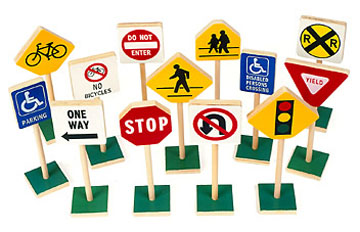

Chapter 4
Time requirement of chapter: 45 minutes
DRIVER & TRAFFIC KNOWLEDGE
This chapter will help you to recognize and appreciate the vital role of vehicle control and procedures in the safe and efficient operation of a motor vehicle. The chapter will challenge you on time and space when changing speed and direction. The chapter will discuss how to safely and efficiently drive a vehicle from one location to another.
To read video transcript CLICK HERE |
|
||||||||||||||||||||||||||||||||||||||||||||||||||||||||||||||||||
Now, we want to continue to provide you with information which may affect the time and space necessary to provide a space cushion around your vehicle and have you consider factors which will require vehicle control.
Anti-Lock Brakes System (ABS):
What ABS does is similar to a person pumping the brakes. It automatically changes the pressure in your car’s brake lines to maintain maximum brake performance just short of locking up the wheels. ABS does this very rapidly with electronics. ABS works with your regular braking system by automatically pumping them. When your wheels lock up on wet and slippery roads or during a panic stop, you may lose traction and control, causing your vehicle to spin.
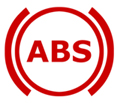 |
Anti-lock brakes keep your wheels from locking up, so your car maintains directional control around hazards, if you can’t make a complete stop in time. ABS is designed to help the driver maintain control of the vehicle during emergency braking situations and may not make the car stop more quickly. In vehicles equipped with ABS, your foot should remain firmly planted on the brake pedal, while ABS pumps the brakes for you, so you can concentrate on steering to safety. When ABS is activated, you may experience a slight vibration or rapid pulsation of the brake pedal, almost as if the brakes are pushing back at you. At times, you will feel the pedal suddenly drop. This means your valves in the ABS unit may make a grinding, scraping or buzzing noise. This means your ABS is working. |
Continue to apply firm pressure and steer. Do not take your foot off the brake pedal. One way to familiarize yourself with the operation of ABS is to test drive the vehicle at a speed above which the ABS activates (usually above 10 mph) in an unobstructed parking lot and apply the brakes firmly. Pulsation may be felt in the brake pedal and you may hear a clicking sound. Avoid pumping the brake, even if the pedal is pulsating.
Resource: http://www.mucda.mb.ca/aboutabs.htm, http://www.erieinsurance.com/SafeCsmr/Safety/DrivingSafe/TipsForAntilockBrakes.htm, http://autorepair.about.com/cs/generalinfo/a/aa052001a.htm, http://www.iihs.org/research/qanda/antilock.html
Airbags:
Airbags are actually part of the safety restraint systems of vehicles, but the information is added at this point because airbag systems and vehicle’s systems are closely connected.
Airbags are designed to work with safety belts, not by themselves. Airbags, by themselves, have a fatality-reducing effectiveness of only 12%. Airbags inflate in 1/20th of a second and at a rate of approximately 200 mph. The following are some safety tips to consider when operating vehicles with airbags.
|
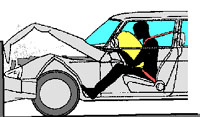 |
Most drivers (even those under 5 foot 4 inches) can get at least 10 inches from the steering wheel and still reach the pedals. Does the steering wheel have a telescoping adjustment? The few who cannot get 10 inches from the steering wheel and still comfortably reach the pedals may wish to consider pedal extenders. Information about pedal extenders may be available from your vehicle dealer.
Resources: http://www.consumeraffairs.com/news04/2006/airbags/airbag_safety_tips.html, http://www.nhtsa.gov/people/injury/airbags/airbags03/images/Air%20Bags0307.pdf, http://www.nhtsa.dot.gov/PEOPLE/outreach/safesobr/12qp/airbag.html
Speed:
Speed influences the crash in four basic ways:
It increases the distance a vehicle travels from when a driver detects an emergency, when the driver reacts, and either attempts to stop the vehicle or steers around the opposing object or vehicle. It increases the distance needed to stop a vehicle once an emergency is perceived.
Crash severity increases by the square of the speed so that, when speed increases from 40 to 60 mph, speed goes up 50% while the energy released in a crash more than doubles.
Higher crash speeds reduce the ability of vehicles, restraint systems, and roadway hardware such as guardrails, barriers, and impact attenuators to protect occupants.
Florida law 316.183 states, no person shall drive a vehicle on a highway at a speed greater than is reasonable and prudent under the conditions and having regard to the actual and potential hazards then existing. In every event, speed shall be controlled as may be necessary to avoid colliding with any person, vehicle, or other conveyance or object on or entering the highway in compliance with legal requirements and the duty of all persons to use due care. Exceeding the posted limit or driving too fast for conditions are two of the most prevalent factors contributing to traffic crashes. Speed is a factor in nearly one-third of all fatal crashes. Speed-related crashes cost society more than $40.4 billion a year. Many drivers do not view speeding as an immediate risk to their personal safety or the safety of others. Yet, speeding reduces a driver’s ability to steer safely around curves or objects in the roadway, and it extends the distance required to stop a vehicle in emergency situations. |
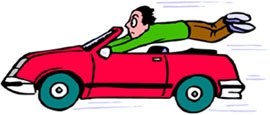 |
Crash severity increases with the speed of the vehicle at impact. Inversely, the effectiveness of restraint devices like air bags and safety belts, and vehicular construction features such as crumple zones and side member beams decline as impact speed increases. The probability of death, disfigurement, or debilitating injury grows with higher speed at impact. Such consequences double for every 10 mph over 50 mph that a vehicle travels.
There are a lot of reasons drivers give for speeding. One is there is an emergency at home or they are late for an appointment. Another is the myth speeding will save them a significant amount of time. It could be the false belief if they do not stay with the flow of traffic they will be run over. Maybe they believe by speeding they prevent someone from tailgating them.
The reality is most people speed because of their emotions. Emotions will be discussed in greater detail later in the course.
Florida State Statute 316.1895 establishes school speed limits to be set at not less than 15 mph, except by local regulation, and not more than 20 mph in an urbanized area. School speed limits are enforced 30 minutes before, during, and 30 minutes after periods of time when students are arriving at a regularly scheduled breakfast program or a regularly scheduled school session and leaving a regularly scheduled school session.
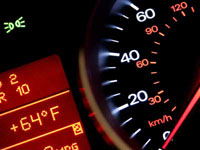 |
Speed limits in Florida - under ideal conditions: A driver may not drive a vehicle on a roadway designated as a school zone at a speed greater than what is posted in the school zone. School zones - speed is set at 20 mph with zone's start and end posted. Residential district speed limits are set at 30 mph, unless otherwise posted. Business district speed limits are set at 30 mph, unless otherwise posted. Streets and highways - between 35-55 mph, unless otherwise posted. Expressways as part of the Interstate System are set at 70 mph, unless otherwise posted. Rural interstate and limited access highways are set at 70 mph, unless otherwise posted. Rural speed limits are set at 55 mph, unless otherwise posted. |
School Zones:
Florida state law 316.1895 establishes school speed limits to be set at not less than 15 mph, except by local regulation, and not more than 20 mph in an urbanized area. Speed limits in school zones may be enforced 30 minutes before, during, and 30 minutes after periods of time when pupils are arriving at a regularly scheduled breakfast program or a regularly scheduled school session and leaving a regularly scheduled school session.
A driver may not drive a vehicle on a roadway designated as a school zone at a speed greater than that posted in the school zone. Speeding fines are doubled for speeding in school zones above 5mph over the posted school speed limits. A driver is cited for exceeding the speed limit by up to 5 mph in a legally posted school.
Construction Zones:
In marked construction zones, speeding fines are doubled for violation of posted speed limits if there were workers present in the work zone at the time of the violation. Keep in mind that some construction zones are several miles long; and just because there are no workers in the area where a speeding violation took place, does not mean the fines will not be doubled if the police officer issuing the citation can prove there were workers at some location within the workzone when the violation took place.
Florida law also states that no person shall drive a motor vehicle at such a slow speed as to impede or block the normal and reasonable movement of traffic, except when reduced speed is necessary for safe operation or in compliance with law.
Speed Limit Violation Fines:
Florida State Statute sets the amount of civil penalties as follows:
Courts set the fines for mandatory appearance violations within the guidelines established by law.
Court costs are in addition to the stated fines listed above and will be imposed by the court in the amount not less than the following:
Resources: 36. http://www.witntv.com/home/headlines/11438466.html, http://www.nhtsa.dot.gov/people/injury/research/speed_volII_finding/SpeedVolumeIIFindingsFinal.pdf, http://www.saferoads.org/issues/fs-speed.htm, http://www.nhtsa.dot.gov/people/injury/enforce/Speed_Forum_Presentations, http://usww.com/homepage/starteam/speed2.html, http://www.iihs.org/sr/pdfs/sr4301.pdf, Florida State Statutes: 316.183, 316.185, 316.187, 316.189, 316.1893, 316.1895 and 318.18.
Sharing the Roadway with Others:
As drivers we share the roadways with many different types of roadway users. Traffic laws and common courtesy are necessary for creating safe roads that can be shared by everyone. Unfortunately too many of us forget the simple rules that we are taught as children, namely, to practice the concepts of concern and respect for others. No question about it, each of us needs to know the rules and our rights as drivers and other roadway users. Therefore, it is important to know the preventative actions to take in order to prevent collisions with these other users.
Motorcycles:
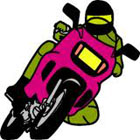 |
Motorcycle riders should ride in the left-hand portion of a traffic lane. This provides the best visibility and keeps the tires out of the center of the lane where most of the oil and dirt residue is found. Motorcyclists should never travel in the same lane with any 4 wheel or larger vehicle. Motorcycles can be hard to see, so the headlight should always be illuminated. Motorcyclists should wear protective equipment when driving. This should include over-the-ankle footwear; a crash tested and approved motorcycle helmet, an approved eye protective device or face shield designed for use with and as part of an approved motorcycle helmet, long pants, a long sleeve shirt, and gloves. Motorcyclists should dress to be visible to other users of the roadways. |
Since motorcycles are hard to see, drivers must always double check before pulling out into an intersection or roadway. Before making any turn, scan into the on-coming lane to ensure there is no motorcycle approaching. Drivers following motorcycles should increase their following distance.
Persons operating a moped on a roadway at less than the normal speed should ride as close as practical to the right-hand curb or edge of the roadway, except when passing or making a left turn. When operating a moped with the engine running, a driver normally has all the rights and duties as drivers of any other motor vehicle. If the moped can also be powered by pedalling if in pedal mode, the rider has all the rights and responsibilities as does a bicyclist or pedestrian.
Since mopeds are similar to motorcycles, the same rules for scanning and following distances apply.
Resources: Florida State Statutes, 322.0255, 316.2208, 316.2085, 316.208, 316.209,
http://www.msf-usa.org/downloads/Riding_Tips.pdf, http://www.nhtsa.dot.gov/people/injury/pedbimot/motorcycle/motosafety.html.
Bicyclists:
Bicyclists are required to follow the same traffic laws as any other vehicle using the roadways. They also have the same rights as other users. Bicyclists are supposed to adhere to all the same traffic laws as an automobile driver, but often fail to do so.
A bicyclist may not ride other than upon or astride a permanent and regular attached seat. A bicycle may not be used to carry more persons at one time than the number of permanent seats attached to the main frame of the bicycle. An adult rider may legally carry a child securely attached to his or her person in a backpack or sling. Bicyclists are required to ride as close as possible to the right curb or edge of the road unless making a left turn or passing another bicycle or vehicle or to avoid any condition that may cause an unsafe act by the bicyclist. Persons riding bicycles may not ride more than two abreast in any single lane. If when riding two abreast, traffic is obstructed, bicyclists are required to ride single file until such time as traffic is no longer obstructed. |
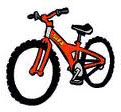 |
All bicycle riders must keep at least one hand on the bicycle handlebars at all times.
Every bicycle in use between sunset and sunrise shall be equipped with a lamp on the front exhibiting a white light visible from a distance of at least 500 feet to the front and a lamp and a reflector on the rear that can be seen for a distance of 600 feet to the rear. It is also recommended that bicycles have reflective material that can be seen in vehicle headlights for a distance of 600 feet to each side. Bicycles are required to have brakes which are able to stop the bicycle in a distance of 25 feet or less when travelling at 10 mph.
Drivers of all vehicles should keep an eye out for bicyclists and be willing to share the road. Drivers should be prepared to give up the right of way at times, thus protecting themselves and the rider of the bicycle. When driving next to or passing a bicyclist, a driver is required to give a minimum of 3 feet of clearance between their vehicle and the bicyclist. This Florida Law helps in preventing debris from the roadway from flying up and striking the bicycle rider. Before exiting your vehicle, make sure there is no bicyclist passing your car before opening the car door. Also remember to increase your distance when following a bicyclist. If for some reason the rider falls, they have very little protection to keep them safe.
Resources: http://www.hpd.org/html/bike_riding_tips.html, http://www.betterhealth.vic.gov.au/bhcv2/bhcarticles.nsf/pages/Cycling_health_and_safety_tips?open. Florida State Statute: 316.2065
Pedestrians:
It is the motorist’s responsibility to do everything possible to avoid colliding with any pedestrian. Yet, pedestrians also have responsibilities under the law. In residential areas, a driver should reduce speed and drive as far away from the curb or parked vehicles as safely possible while still driving within a single lane. Never assume that a pedestrian of any age knows or will follow the law.
At marked crosswalks, pedestrians should be yielded the right-of-way. Remember, drivers should yield to pedestrians crossing the street or driveway at any marked mid-block crossing, driveway or intersections without traffic signals. Since pedestrians and especially children don’t always follow the rules, drivers need to be especially alert in the areas of bus stops, train stations, subway stations, near schools and parks and in shopping areas. Prior to entering the vehicle - walk around it to check for children, pets or toys - in front and behind. You may not see them in mirrors, rear window or on a back-up camera screen. Pedestrians are required to follow the traffic laws just like drivers. They should never assume a driver sees them or will stop even if they do. |
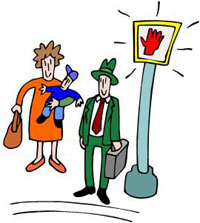 |
If there are no sidewalks available, pedestrians should walk on the side of the road facing oncoming traffic. Also, before stepping off the curb, pedestrians should look left first, then right and then left again before entering into the lanes of travel.
When jogging, they should run facing traffic and wear reflective clothing and never listen to music through headphones.
Special attention is required when a driver sees a pedestrian walking with a red tipped white cane or with a trained guide dog. The law requires all drivers to yield the right-of-way to a visually impaired individual. If a driver sees a pedestrian with either a white red tipped cane or walking with a guide dog, they are required to come to a complete stop and remained stopped until such time as the visually impaired pedestrian has cleared all the lanes of traffic.
Where sidewalks are available, pedestrians are required to use them and not walk on the roadway unless there is some reason the sidewalk cannot be used. Pedestrians are not allowed to cross intersections diagonally. This is called “Jay Walking.” Pedestrians are also prohibited from walking on freeways or their right-of-ways.
Resources: http://www.wsdot.wa.gov/Walk/Safety_Tips.htm,. http://www.hsrc.unc.edu/safety_info/pedestrian/safety_tips.cfm, Florida State Statute: 316.130
Large Vehicles:
Most people do not realize that collisions involving automobiles and trucks occur in daylight, on straight and dry pavement, under good weather conditions, more often than at night and in inclement weather. Trucks are larger and heavier than passenger vehicles; and, in four out of five fatal collisions, it is the driver of the passenger vehicle, not the truck, who is killed.
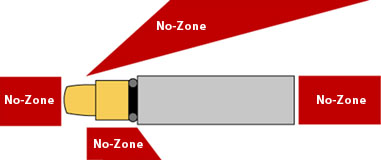 |
Large vehicles have blind spots known as “No Zones.” These “No Zones,” are located to the front, rear and both sides of the vehicle. One way to know if you are driving in a “No Zone,” of a large vehicle is to check for their mirrors. If you cannot see the driver in their outside mirrors, then the driver most likely cannot see your vehicle. If you are following a large vehicle at night, use only your vehicles' low beam headlights. When driving behind a large vehicle, maintain at least a minimum of a four (4) second following distance. Increase the following distance if there are additional environmental factors. |
Large vehicles are much longer than a car, and will take longer to pass. When attempting to pass, maintain a constant speed and be sure you can see the entire cab of the truck including front bumper and tires in your rear-view mirror before pulling in front of the truck. If you are being passed by a large vehicle, slow down slightly, since dust or dirt from the vehicle tires can reduce your visibility. Be especially careful when passing a large vehicle that is also pulling a trailer. There are times when the trailer will swing into your lane - crosswind or a steering correction to avoid debris.
Large vehicles need additional turning space, so never try to squeeze into the space next to a large vehicle when either they or you are making a turn. If the large vehicle must swing wide to safely complete its turn, it might just strike your vehicle in its blind spot (no zone).
There are stories of drivers who get very close to the back of a large vehicle while traveling on a freeway with the intention of getting into the vacuum found behind large vehicles travelling at higher speeds. These drivers believe this will save them fuel. This is extremely dangerous because there is no way you can stop your vehicle before impact, in the event the large vehicle experiences an emergency.
If you are travelling on multilane highways, do not get in between large vehicles. Since you are in the vehicles’ no zone, they may shift into your lane forcing you into the other vehicle.
When stopped behind a large vehicle on a hill or upgrade, it is a good idea to leave space between your vehicle and the one directly in front, in case the vehicle rolls back slightly when it starts to move forward.
The best defensive driving tactic when driving near large vehicles is to stay away from them.
Resources: http://www.mayflower.com/moving/full-service-movers/moving-tips/safe-driving.htm, http://www.dmv.state.va.us/webdoc/safety/programs/motorcarrier/index.asp, http://www.tc.gc.ca/roadsafety/sharetheroad/page2.htm.
Slow-moving vehicles:
Slow moving vehicles are usually designed for speeds under 25 miles per hour; and include horse-drawn wagons or carriages, roadway and construction equipment, farm tractors and wagons. These vehicles move much slower than the normal traffic, or may be crossing the road slowly. Slow moving vehicles should display special warning signs which help drivers identify them as a slow moving vehicle. These vehicles can only be operated during daylight hours, unless equipped with night driving equipment lights and reflectors. |
 |
Especially wide or long vehicles are required to display a wide load sign or overside load. Many are required to be escorted by a pilot / warning vehicles which will utilize flashing lights to warn drivers of the special hazard. Drivers identifying a slow moving vehicle should reduce their speed and maintain a safe following distance. Passing should be done in an area that is safe and legal. It is never legal to pass a slow moving vehicle, if the maneuver will require going over the posted speed limit.
Never attempt to pass a slow moving vehicle on a curve, hill, or intersection. What most drivers fail to realize is that slow moving vehicles are not normally driving their vehicles long distances, so if they would be patient and wait the few extra minutes for them to clear the roadway they will cause themselves a lot less stress.
Resources: http://publicsafety.ohio.gov/odps_publications/HSY%208203_Rural_Driving_11_05.pdf, http://www.roadtripamerica.com/DefensiveDriving/Rule36.htm.
School Buses:
A driver, upon approaching any school bus which displays a stop signal and is completely stopped, shall bring their vehicle to a full stop behind the school bus or if on a two lane road prior to reaching the front of the school bus, and remained stopped while the bus is stopped. The driver may not pass the school bus until the signal has been withdrawn, and the red flashing lights have been turned off.
A driver of a vehicle upon a divided highway with an unpaved space of at least 5 feet, a raised median, or a physical barrier, is not required to stop when traveling in the opposite direction of a school bus which is legally stopped. If driving in the same direction on the divided highway, vehicles behind the bus must stop. Any driver passing a stopped school bus that has the stop sign extended and the vehicles red lights flashing while loading or unloading students is subject to having 4 points accessed on their driving record upon conviction.
If a driver passes a stopped school bus, they are subject to a minimum fine of $100 for each offense; and for a second offense within 5 years, the driver's license of the violator will be suspended for no less than 90 days and no more than 6 months. If a driver passes a stopped school bus on the side of the bus that children enter or exit, they are subject to a minimum $200 fine for each offense. For a second offense of the same kind within 5 years, the driver's license will be suspended for no less than 180 days and no more than 1 year. In addition to all other penalties, a driver in violation of the school bus laws will have to attend and complete a basic driver improvement course.
In addition to the penalities above there is $65 for a violation of Florida State Statute 316.172(1)(a) or (b), Traffic to stop for school bus. If the alleged offender is found to have committed the offense, the court shall impose the civil penalty captioned above plus an additional $65. The additional $65 collected under this paragraph shall be remitted to the Department of Revenue for deposit into the Emergency Medical Services Trust Fund of the Department of Health.
Resources:Florida State Statutes: 316.172, 322.27, 318.18, 318.19, , 318.18 (5) (c)
Right-of-Way:
Florida law does not give the right of way to anyone; it says who must yield the right-of-way and under what circumstances. The right-of-way is always given up by one or another of the drivers.
In other words, the law does not allow a driver to command the right-of-way. Just because a driver says they were at an intersection first, does not excuse them from preventing a collision if possible. Under Florida law, every driver, pedestrian and bicycle rider must do everything possible to avoid a collision.
The basic right-of-way rule at an intersection states when two vehicles approach or enter an intersection from different highways at approximately the same time, the driver of the vehicle on the left shall yield the right-of-way to the vehicle on the right. The driver of a vehicle intending to turn to the left within an intersection or into an alley, private road, or driveway shall yield the right-of-way to any vehicle approaching from the opposite direction, which is within the intersection or so close as to constitute an immediate hazard. The driver of a vehicle approaching a yield sign shall slow to a speed reasonable for the existing conditions; and, if required to stop for safety, shall stop at a clearly marked stop line. If none is marked, stop before entering the crosswalk on the near side of the intersection, or at the point nearest the intersecting roadway where the driver has a view of approaching traffic on the intersecting roadway before entering it. |
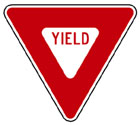 |
After slowing or stopping, the driver shall yield the right-of-way to any vehicle in the intersection or approaching on another roadway so closely as to constitute an immediate hazard during the time such driver is moving across or within the intersection or junction of roadways.
A driver about to enter or cross a roadway from any place other than another roadway shall yield the right-of-way to all vehicles approaching on the roadway to be entered or crossed.
A driver emerging from an alley, driveway, building, parking lot, or other place, immediately prior to driving onto a sidewalk or into the sidewalk area extending across any such alleyway, driveway, or entranceway, shall yield the right-of-way to any pedestrian upon or about to enter such sidewalk or sidewalk area extending across such alleyway, driveway, or entranceway, as may be necessary to avoid collision.
When changing lanes, a driver is required to yield the right-of-way to a vehicle in an adjacent lane that is close enough to cause an immediate hazard.
Drivers are also required to yield the right-of-way to all pedestrians with a red tipped white cane or walking with a guide dog and to all pedestrians in marked cross walks.
Remember, when traffic signals malfunction, drivers are to treat the instersection as an automatic stop intersection and must come to a complete stop before proceeding and follow the right-of-way rules of stop instersections.
Resources: http://golocalnet.net/drive/select6.htm, http://www.roadtripamerica.com/DefensiveDriving/Drive-Safe-With-Uncle-Bob.htm, http://www.driverlicenseschool.com/src/florida-drivers-handbook/3-9.html, http://golocalnet.net/drive/rofway.htm, Florida State Statutes: 316.072, 316.123, and 316.125, 37.
VEHICLE EMERGENCIES
Vehicle Skids:
In the event of a skid, a driver should never slam on the vehicle brakes. A driver should remove their foot from the vehicle accelerator and focus on where they want to the vehicle to go. The driver should steer in the direction they want the vehicle to travel. Some drivers may over-steer, but they should keep steering in the direction they want the vehicle to travel until the vehicle has fully recovered from the skid or safely stopped.
Resource: http://www.roadragers.com/tips/driving-on--ice.htm,http://www.besmartbesafe.ca/safety-winterdriving.asp.
Tire Flats and Blowouts:
When a driver experiences a flat tire, they will usually feel a vibration in the steering wheel and may hear noise coming from that side of the vehicle. Newer vehicles may have a dash board light to report a low tire pressure. Do not slam on the vehicle's brakes, but release the accelerator and let the vehicle slow to a stop. Look ahead to locate a safe place to move the car completely off the road. Move the vehicle off the paved portion of the roadway, and use the vehicle emergency flashers and other warning devices to alert other motorists.
Tire blowouts can be very dangerous. Take your foot off the accelerator / gas pedal. Never use the vehicle brakes. Maintain a firm grip on the steering wheel and release the accelerator. Once the vehicle has slowed down and is under control, brake gently and pull the vehicle completely off the roadway.
Resource: http://en.wikipedia.org/wiki/Flat_tire,
http://www.helium.com/knowledge/64046-how-to-drive-through-a-tire-blowout?page=2.
Vehicle Brake Failure:
If a vehicle's brake system becomes wet when driving through puddles of water, they may tend to fade or pull to one side. Drivers should slightly test the brakes after a puddle way by pressing the brake peddle in an attempt to dry out the brake lining. If after a couple of tries, the vehicle's brakes do not respond as they should by slowing the vehicle, the driver should pull the vehicle off the road, stop and call for emergency service.
Total brake failure can be one of the most frightening experiences a driver can have. Keeping calm is the first thing to remember. If the vehicle is equipped with standard brakes, a driver can try pumping the brakes pedal hard and fast. If the vehicle has anti-lock brakes, never try and pump the brakes. If there is total brake failure, a driver can shift to a lower gear and apply the emergency brake slowly while pressing in the release button or leaver. This will keep the rear wheels from locking up. It may be necessary to rub the vehicle tires against the curb in an attempt to stop the vehicle. There maybe times when a driver will be required to drive off the paved portion of the roadway, utilizing the dirt to slow the vehicle to a stop. In extreme circumstances, a driver may have to strike a fixed object.
Resource: http://www.icbc.com/road_safety/roadsafety_tips_season_wet.asp,http://www.smartdriving.co.uk/Driving/Driving_emergencies/Brakes_fail.htm,http://www.wikihow.com/Stop-a-Car-with-No-Brakes.
Vehicle Engine Stalls:
When a vehicle engine stalls, the brakes and steering wheel will still operate, but will lose the power assist and will be a lot harder to control. A driver should activate the vehicle's turn signal, steer off the roadway and come to a complete stop. Put the vehicle in park or neutral and try and restart the engine. Never leave a stalled vehicle in the roadway. Try and push it off the roadway. If the vehicle will not start after several attempts, call for assistance. Never pour gasoline in a vehicle's carburetor to start it. Activate hazard lights / emergency flashers to alert other drivers.
Resource: http://itd.idaho.gov/dmv/driverservices/documents/DLChapter4.pdf
Vehicle Power Steering Failure:
When there is power steering failure, normally the vehicle can still be steered; however it will be much harder. A driver should brake gently, activate emergency flashers and bring the vehicle to a complete stop off the roadway. Do not slam on the vehicle brakes. Call for assistance.
Resource:http://www.ehow.com/how_5207_handle-power-steering.html.
Vehicle Accelerator Gets Stuck:
An accelerator (gas pedal) may get stuck because of a floor mat becomes wedged preventing movement of the pedal linkage. A broken engine mount; the linkage or accelerator springs become stuck, or there may be an object near the accelerator pedal. A driver should shift the vehicle into neutral and slowly brake the vehicle. Maintain control and steer off the roadway and stop. After the vehicle is safely off the roadway, put the transmission into the park position, turn off the ignition and engage the emergency brake. After checking the accelerator pedal for any obstructions, attempt to restart the engine. If the engine still races, again shut off the vehicle. Check again for any objects near the pedal. If the engine is still accelerating, stop the vehicle and call for emergency help. Never attempt to drive the vehicle until repairs are completed.
Resource:http://www.landtransport.govt.nz/roadcode/about-driving/tips-for-handling-drivingemergencies.
html.
Vehicle Engine Overheats:
Driving a vehicle that is overheating can cause tremendous damage to the engine. Pull the vehicle off the road and stop. Turn on the vehicle heating unit on high and see if this helps cool down the engine. If there is steam coming from the vehicle, immediately stop the vehicle. Let it cool down before checking for any broken hoses or belts. Do not open the hood while steam / smoke is visible. Once the vehicle is cool, the radiator can be checked and fluids added.
Resource: http://www.essortment.com/hobbies/whatdooverheat_seqv.htm.
Most drivers do not pay very much attention to their vehicle's exhaust system. A driver should be aware of how they can reduce the risks of carbon monoxide poisoning from their vehicles. A driver experiences symptoms consistent with carbon monoxide poisoning, whenever they are driving if exhaust enters the passenger compartment.
Some symptoms of carbon monoxide poisoning may include headaches, dizziness, tiredness, flu-type symptoms, nausea and even loss of consciousness.
If your vehicle is stored in a garage at home, you should never leave the engine running at idle in this enclosed space. This can cause a buildup of carbon monoxide fumes in the garage area. The CO pollution could seep in to the house, posing a serious risk to everyone in the home. So, if you must run your vehicle in the garage, make sure the garage door is open, and vents / doors to the living areas are closed.
Owners/Drivers are advised to ensure that they have their vehicle's exhaust system checked regularly for excessive CO emissions; especially during the colder winter months, as this could help to protect you and others.
The risks of death are further increased from vehicle CO poisoning, if the driver starts to become drowsy or feel unwell from the CO leaking into the vehicle when they are driving.
The following are some tips on avoiding Carbon Monoxide poisoning from vehicles:
Florida state Statute 316.272 requires every motor vehicle to at all times be equipped with an exhaust system in good working order and in constant operation, including muffler, manifold pipe, and tail-piping, to prevent excessive or unusual noise. No person shall use a muffler cutout, bypass, or similar device upon a vehicle on a highway. The engine and power mechanism of every motor vehicle shall be so equipped and adjusted as to prevent the escape of excessive fumes or smoke. A violation of this section is a non-criminal traffic infraction.
Resources: http://www.cdc.gov/co/faqs.htm, http://www.silentshadow.org/carbon-monoxide-in-your-car.html,
Florida State Statutes, 316.272,
CHAPTER 4 QUIZ
| Question 1 | Anti-lock brake systems (ABS) may not make a car stop more quickly.
|
||||||||
| Question 2 | Airbags inflate in 1/20th of a second and at a rate of approximately ____ mph.
|
||||||||
| Question 3 | Never have a child under the age of ___ seated in the front seat of a vehicle equipped with passenger-side airbags.
|